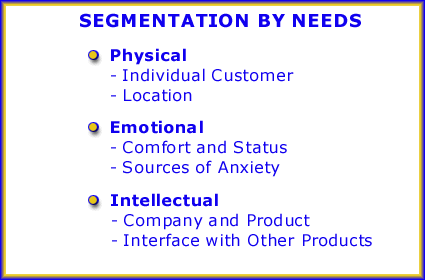BASIC STRATEGY GUIDE: STEP 12
Activity One (Steps 1-12):
Segment customers, both by size and by need, to identify targets for the Company.
Step 12: Develop new need-based segmentation

What:
Segment the Core customers according to the unmet needs they may have today. For a quick review of these potential unmet needs, please see our Perspective, “Customer Segmentation: Finding the Human Dimension.”
In searching for potential customer need segments, consider the costs incurred, or steps each customer takes, with the product over the entire life of the product.
To do this, the Company should take a small sample of target Core customers who would be complementary to, rather than competitive with, one another. A customer is complementary, rather than competitive, with another customer if the Company may sell to both customers without creating bitter feelings through channel conflict. In our experience, customers who are two or more customer size categories apart from one another are usually complementary:
-
Pick two complementary sizes of Core target customers, for example, some Very Large customers plus some Medium customers, or some Large customers plus some Small customers.
-
Generally, these customer size pairings, e.g., Very Large and Medium, will not view each other as direct competitors and will also have different needs in the marketplace.
Use this sample of target customers and their costs to develop new need-based segments. Innovate potential new segments of the Core target customers beginning with the following high level needs:
-
Physical
-
Emotional
-
Intellectual
Set priorities for the innovation programs to meet the needs of these new Core customer segments:
-
Determine the segments with the largest potential sales volume if the needs are met.
-
Consider the Company’s ability to meet those needs compared to the abilities of its closest and most capable competitors.
Why:
This step completes the customer segmentation in the market place. The first segmentation the Company undertakes segments customers on the basis of the potential size of their relationships with the Company. That segmentation reflects the way the Company and its competitors serve customers today. This new segmentation seeks to change the basis of competition by finding Core customer segments that have unmet needs in today’s market.
What to Watch For:
-
The company would develop need-based segments for both Intermediary and Final customers, if both exist.
-
As an industry matures, and especially if it becomes Hostile, the most important “customer” often becomes the Intermediary customer. The Final customer is more important in Developing and some Stable industries where new functions, branding and, sometimes, lower prices are critical to success.
-
By far, the most common segmentations are those around emotional characteristics, especially needs to avoid sources of anxiety.
-
The leading top level characteristics for segmentation where the Intermediary customer buys from a producer are:
-
Emotional/economic limitations
-
Emotional/time limitations
-
Emotional/risks in the relationship
-
Intellectual/familiarity with the company and product
-
-
The leading top level characteristics for segmentation where the Final customer buys from a producer are:
-
Emotional/time limitations
-
Emotional/economic limitations
-
Emotional/risks in the relationship
-
Emotional/status in the community
-
-
The leading top level characteristics for segmentation where the Final customer buys from an Intermediary are:
-
Emotional/time limitations
-
Emotional/risks in the relationship
-
Emotional/economic limitations
-
Intellectual/familiarity with specific product
-
Action:
From the set of potential need-based Core customer segments, select several for the Company’s product and service improvement innovation program. These segments would be the need-based segments which have the largest potential revenues and profits, as adjusted for the Company’s capabilities compared to competition.
More Information to Create New Customer Segments on the Advanced Site >>
For helpful context on this step:
Perspectives:
Symptoms and Implications:
